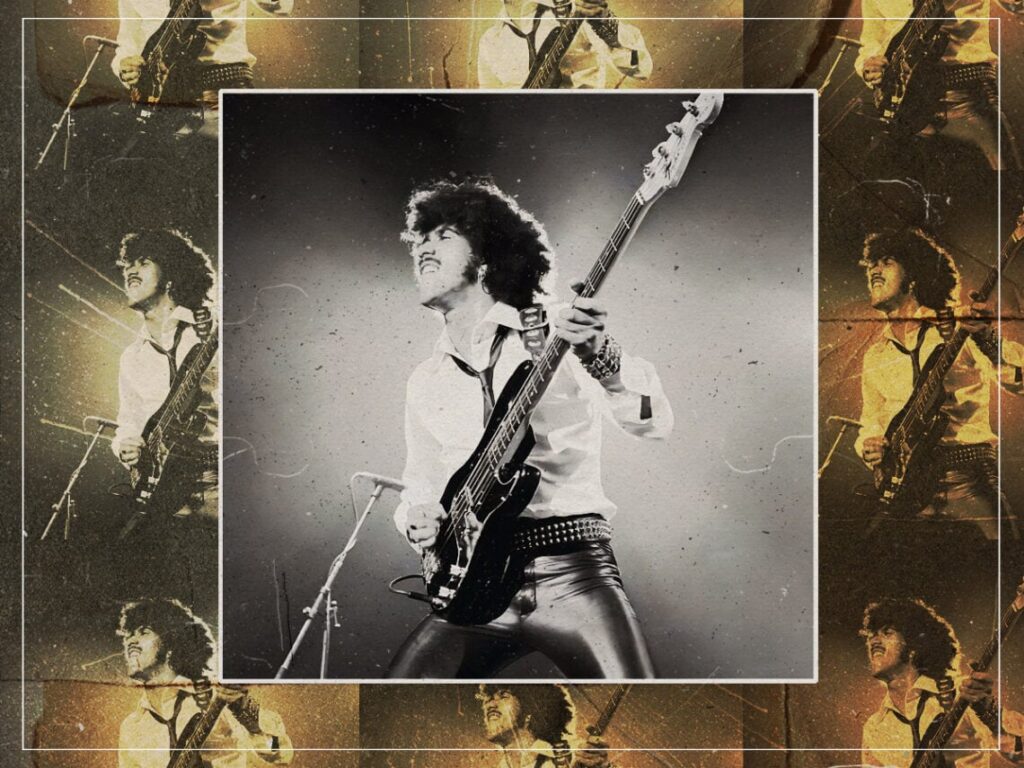The 10 best songs by Thin Lizzy
 Posted On
Posted On
(Credits: Far Out / Thin Lizzy)
Rattling riffs, Celtic lore, grooving basslines, and Phil Lynott’s goluptious roar all made Thin Lizzy one of the premiere rock ‘n’ roll bands of the 1970s. Despite their short-lived tenure, which began in 1971 and famously failed to get off the ground for a long while before breaking through then burning out in 1983, still manages to encapsulate something vital about the genre.
Hailing from Dublin, without sounding too hyperbolic, the band were everything: they were hell-raisers with a rip-roaring sound, and yet they were also mellow, mild and spiritual; they were fighters preaching peace, punks with great talent, and a band of brothers against the world though the band kept on changing. All the while with Lynott as their effortlessly cool leader.
Above all, they were a live band. That is not to say they didn’t make great records; on the contrary, these albums were made to be performed and conceived to continue the circus. As Lynott said regarding a familiar tour feeling: “You can know that the final show is coming up, and prepare yourself for it mentally, but when it finally occurs, it’s like a dream. You stand there feeling the love the audience has for you, and you think, ‘Is this really going to end?’”
Tragically, for Lynott, it ended for good in 1986, at the age of 36, falling an overdose consumed on Christmas day. However, his band’s songs have sustained his spirit, still glowing with relevance and his unique sense of reverie and reconciliation in rock. With this in mind, we’ve championed ten of the best of them below.
The 10 best songs by Thin Lizzy:
‘Sarah’
As the 1970s drew to a close, Lynott welcomed a daughter with her partner, Caroline Crowther. Writing the 1979 single ‘Sarah’ as a tribute to his newborn daughter, the track is much more mellow and melodic than the brash, macho rock music that Thin Lizzy had grown a reputation for.
A beautiful celebration of the love he held for his daughter, the track features heartwarming lyrics regarding how the birth of Sarah “changed [his] world”. Lynott showcases his more sensitive side on the song. The track made it to a modest 24 in the singles chart and although the band never performed the track live, it later became a favourite for Lynott’s post-Lizzy project Grand Slam.
[embedded content]
‘Black Rose (Lizzy)’
There’s something inherently cinematic about Thin Lizzy, but with ‘Black Rose’, they offer up something ‘only to be seen in IMAX on the big screen’. In an epic poem, Lynott weaves his way through Irish culture like a mazy run from George Best while Gary Moore’s liquid guitar barks encouragement from the touchline. Somehow, this creates a track that is decidedly folk in its thinking but utterly new in its performance.
Personal bests have been set in the gym to this song, yet it has also encouraged people to pick up folklore books or delve into the works of Irish literary greats. In short, this encapsulates the intelligent rock that the band were about: never pompous but always informed.
[embedded content]
‘Cold Sweat’
A late-career highlight for Thin Lizzy, ‘Cold Sweat’ was taken from their final studio album, 1983’s Thunder and Lightning. One of the band’s heaviest tracks, the single is a spiritual predecessor to 1980s hair metal. Dealing with topics of gambling, alcohol and money, the song’s lyrics are almost as heavy as the accompanying riffs. However, the undisputed highlight of the song comes with John Sykes’ blistering guitar solo.
Reaching 27 in the singles charts, ‘Cold Sweat’ was the biggest hit of Thin Lizzy’s later career. The band were reportedly invited to perform the track on Top of the Pops, but the offer was rescinded after Lynott had an argument with a stage manager.
[embedded content]
‘Rosalia’
The first track from Thin Lizzy’s 1975 offering, Fighting, came in the form of ‘Rosalie’. A cover of a track by Bob Segar, written about a Canadian radio DJ, Lynott and the band gave the track their signature treatment. Although Segar’s original version does lend itself quite easily to the American rock and blues influences of Thin Lizzy, their version, in many ways, has eclipsed the original.
Charting at number 20 in the UK, the original single release for ‘Rosalie’ was backed with the controversial ‘Half Caste’. The reggae and soul-influenced song explored the racism that Phil Lynott faced during his upbringing as a mixed-race boy in Dublin.
[embedded content]
‘Jailbreak’
With heavy riffs and lyrics exuding the macho masculinity that the band had explored elsewhere, ‘Jailbreak’ is classic Thin Lizzy. Giving its name to the group’s 1976 album, the track tells the story of a prison break-out, with all the rock and roll excess that audiences had come to expect from the Irish rockers.
The single failed to achieve much commercial success, only reaching the heights of 31 in the UK singles charts, but ‘Jailbreak’ has since become viewed as one of Thin Lizzy’s most seminal tracks. The heavy use of a ‘wah-wah’ pedal by guitarist Brian Robertson gives the track a refreshing quality when looking at the seemingly endless sea of mid-1970s hard rock groups.
[embedded content]
‘The Boys Are Back in Town’
Say what you like about the song being macho, gaudy and hollow, but it’s frankly hard to imagine a world without ‘The Boys Are Back in Town’. The band get to the heart of Saturday night so faithfully that the hit has been ubiquitous since it was released. Saloon doors swing at the very sound of it, and pints are poured of their own accord when it blares out the jukebox.
However, the beauty of the hit that has transcended rock and woven its way into society at large is that it isn’t just a laddish chant—there’s mystery and murk in the lyrics, too: who are the boys, and what does their presence in this town herald? Taken from Lynott’s own experience with dodgy characters, the track’s secret weapon is the experiential weight behind it that gives it oomph and shames phoney imitations.
[embedded content]
‘Showdown’
With an intro that sounds so sleazy, you feel the need to hit skip if it plays aloud in public, ‘Showdown’ has a greasy aura of cheesiness about it. But you hear it out, and soon the porno groove crossover towards a soul-adjacent chorus, and suddenly you’re bopping away. A few more bars down the line and you’re happy to open the car window and share the cool hit you’re listening to with the public.
Cleverly, the band maintain this slow and sultry lick for as long as they can, creating a sparse arena for their epic finale to swagger into. The dovetailing stabs of Scott Gorham and Brian Robertson on guitar results in an electrifying farewell that was subtly promised all along, although Lynott’s croon tries to conceal its approach.
[embedded content]
‘Dancing in the Moonlight’
Aside from everything else, Thin Lizzy were simply a really great pop group. They might have threatened you for saying that, but the seamless, toe-tapping musicology and structure that they operated in would betray the truth of it. The compositional brilliance of ‘Dancing in the Moonlight’ is something Elton John would be delighted with.
Moreover, the title itself seems like the sort of thing human beings simply find inherently romantic, as though it is coded in our DNA to respond positively to that phrase. From this endeared position, Lynott takes you back to your youth with specific mentions of chocolate-stained trousers that have you nostalgically reaching your own corroborations.
[embedded content]
‘Dublin’
Lynott in balladeer mode is a novel proposition on the surface. Yet, ‘Dublin’ showcases why it may well have been his natural disposition after all. Without histrionics or any preconceptions, Lynott delves into the duplicities of his hometown. In doing so, he offers up an entirely honest portrait of Dublin and his place within it.
The music fittingly follows suit with stabs of electric urgency layered over the acoustic hum of antiquity. This creates a track that is spiritually tortuous, creating something that is alluring yet almost uneasy with its refusal to resolve itself as neatly as you thought, like an old fable that just doesn’t quite seem to fit the square hole you had prepared for it. Humbly offered on 1971’s New Day EP, this meek offering finds the band at their most unguarded.
[embedded content]
‘Whiskey in the Jar’
Thin Lizzy’s definitive track has to be ‘Whiskey in the Jar’. The traditional Irish folk song, first popularised by The Dubliners, introduced mainstream audiences to the rock and roll sounds of Phil Lynott and Thin Lizzy. The iconic riff of guitarist Eric Bell brings the traditional folk classic firmly into the 20th century. Their second single to be released, ‘Whiskey in the Jar’, also gave the group their biggest hit, peaking at number six in the UK singles chart.
The track itself is a classic Irish drinking song with suitably melancholic undertones. Though not as heavy or energetic as the material Lizzy would later become synonymous with, the song cemented the band as a unique voice in early 1970s rock and roll. The recording acted as a celebration of Lynott’s Irish upbringing, having been brought up by his grandparents in Dublin despite being born in the West Midlands. Countless artists have had a crack at reimagining the folk song over the years, from The Seekers to Metallica, but none have had quite the same impact as Thin Lizzy.
[embedded content]

